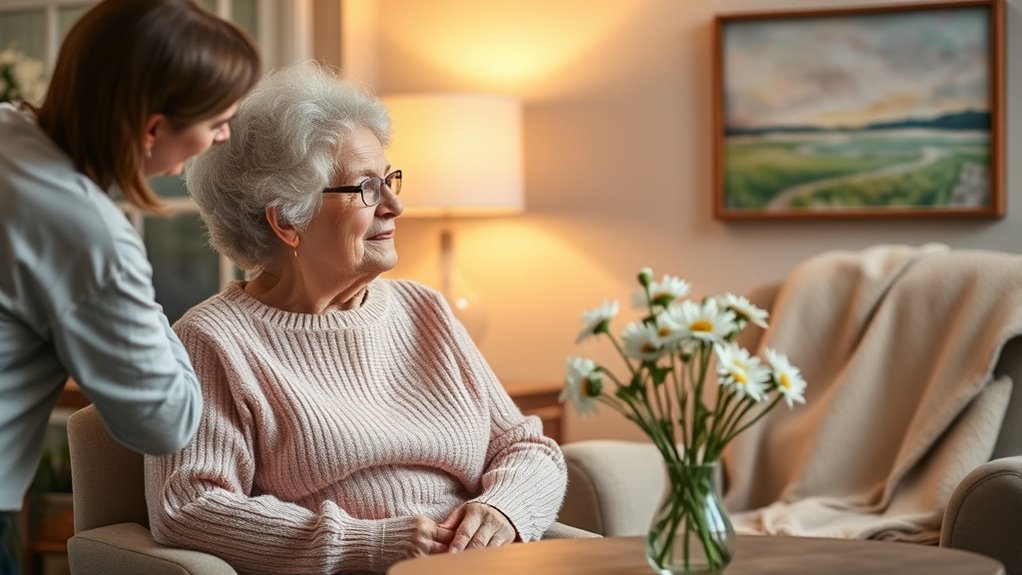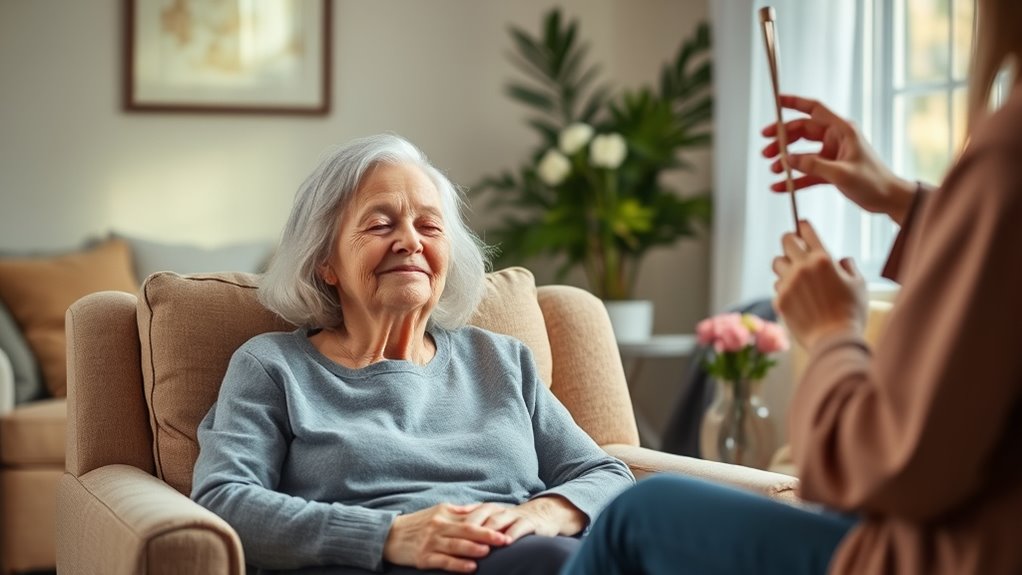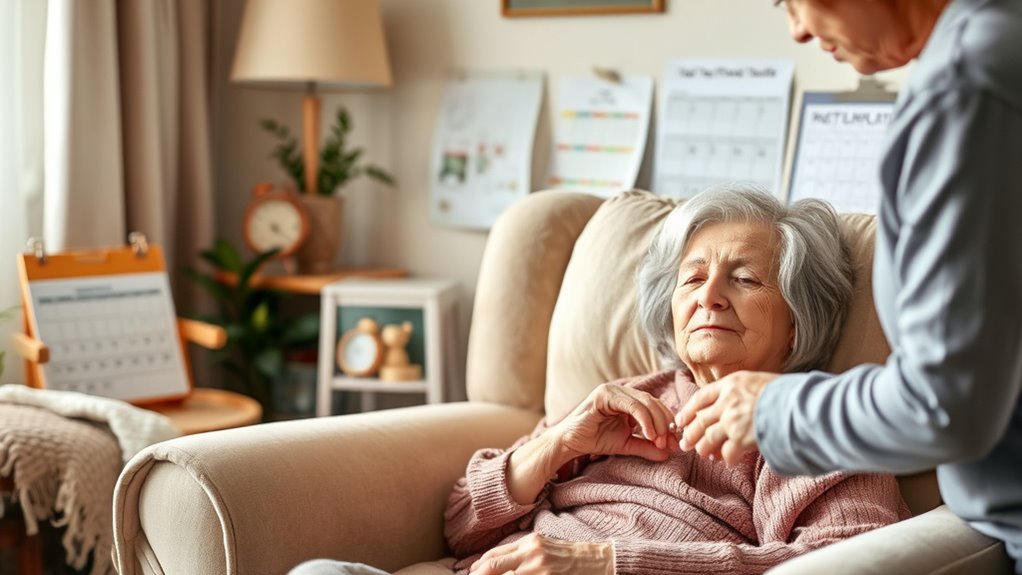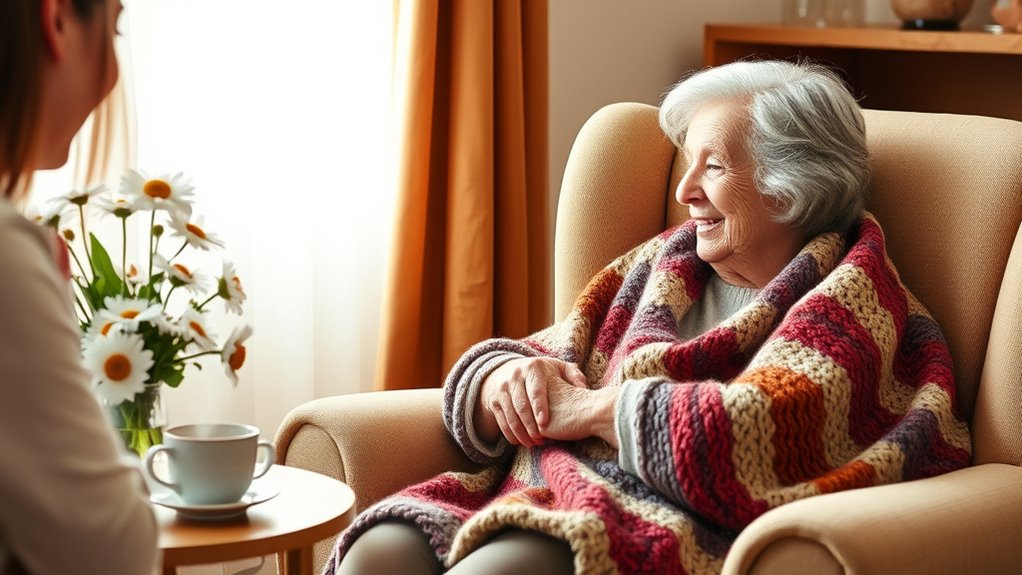To comfort Alzheimer’s patients without drugs, create a calm, safe environment with a consistent routine, soft lighting, and familiar visuals. Use gentle touch, massage, and calming sounds like soft music or nature noises to promote relaxation. Engage them in therapeutic activities or hobbies suited to their abilities and incorporate soothing scents like lavender. Outdoor time and mindful exercises can also help reduce anxiety. Learning these gentle approaches can make caregiving more effective and comforting.
Key Takeaways
- Maintain a consistent routine and a clutter-free, calming environment to reduce confusion and agitation.
- Use sensory activities like gentle touch, aromatherapy, calming music, and nature sounds to promote relaxation.
- Engage patients in hobbies, outdoor walks, and social activities tailored to their interests and abilities.
- Create a peaceful dining setting with attractive presentation, small meals, and minimal distractions to enhance comfort during eating.
- Monitor individual responses, adjust techniques accordingly, and provide emotional support to ensure overall well-being.
Creating a Calm and Safe Environment

Creating a calm and safe environment is essential for reducing stress and preventing confusion in Alzheimer’s patients. You can achieve this by maintaining a consistent daily routine, so familiar activities become predictable. Keep the environment clutter-free and well-lit to minimize accidents and reduce anxiety. Use soft, calming colors in the space to promote relaxation. Limit background noise and avoid sudden loud sounds that might startle or overwhelm. Ensure furniture is stable and easy to navigate, reducing the risk of falls. Keep important items, like glasses or medications, in predictable places so your loved one knows where to find them. By creating a peaceful, organized environment, you help your loved one feel secure and reduce feelings of confusion or agitation. Incorporating mindfulness techniques can further help both caregivers and patients manage stress and promote emotional well-being. Additionally, paying attention to environmental consistency can significantly enhance a sense of security and comfort for individuals with Alzheimer’s. Regularly engaging in environmental assessments can help identify and address potential hazards before they cause issues. Understanding the importance of creative practice can also lead to the development of personalized activities that soothe and engage patients effectively.
Using Gentle Touch and Massage Techniques

Gentle touch and massage techniques can be powerful tools to soothe and comfort Alzheimer’s patients. When performed calmly and intentionally, these methods help reduce anxiety, improve mood, and promote relaxation. Start by choosing a quiet, comfortable space and use slow, gentle strokes. Pay attention to the patient’s responses, adjusting pressure and duration as needed. Consistency and patience are key to building trust and comfort. Incorporating names that evoke a sense of familiarity and warmth can enhance the comforting experience, much like choosing preppy dog names that reflect a refined and soothing aesthetic. Consider these tips: – Use warm, natural oils to enhance relaxation – Focus on areas like hands, shoulders, or arms – Maintain eye contact and speak softly – Observe for signs of discomfort and adjust accordingly. Being aware of divorce laws can also help caregivers plan better for future discussions about legal and financial matters. Additionally, understanding home security systems can provide peace of mind for caregivers and families in protecting their loved ones. Recognizing the importance of emotional well-being can further enhance the effectiveness of these gentle care techniques. Incorporating self-care practicesinto caregiver routines can also help sustain patience and compassion over time.
Incorporating Music and Sound Therapy

You can use calming musical selections to help soothe your loved one and reduce agitation. Personalizing sound experiences guarantees the music resonates with their preferences and memories. Incorporating music and sound therapy into daily routines can create a peaceful environment and enhance their well-being. Exploring anime movies with heartfelt stories can also serve as a comforting activity that stimulates positive emotions. Additionally, the use of sound therapywith nature sounds or music can further promote relaxation and emotional stability. Utilizing sound healing science principles, specific frequencies can be selected to target relaxation and healing effects. Understanding the second trimester changes can also help caregivers better anticipate and address mood swings and emotional needs during this period. Incorporating individualized sound interventions can optimize the therapeutic benefits for each person’s unique emotional responses.
Calming Musical Selections
When used thoughtfully, calming musical selections can considerably ease anxiety and agitation in Alzheimer’s patients. The right music creates a soothing environment and helps patients feel more secure. Choose gentle melodies, soft instrumentals, or familiar tunes from their past to promote relaxation. You can also consider:
- Playing classical music, like Mozart or Bach, known for calming effects
- Using nature sounds, such as flowing water or birdsong, to foster serenity
- Selecting slow-tempo music with simple rhythms to avoid overstimulation
- Incorporating personalized songs that hold special significance for the individual
Personalized Sound Experiences
Personalized sound experiences can considerably enhance comfort for Alzheimer’s patients by tailoring music and sound therapy to their individual preferences and histories. You might discover that certain songs or sounds evoke positive memories or calm agitation. Incorporate familiar music from their past, such as favorite childhood tunes or songs linked to special moments. Using recordings or playlists that resonate personally can help reduce anxiety and improve mood. You can also adjust sound levels to ensure they’re comfortable and not overwhelming. Pay attention to how your loved one responds, and be flexible in modifying the selections. Personalizing sound experiences creates a sense of familiarity and security, making daily routines more soothing and engaging. This approach fosters emotional connection and supports their overall well-being without medication.
Engaging in Therapeutic Activities and Hobbies

Engaging in therapeutic activities and hobbies can substantially enhance the well-being of Alzheimer’s patients by providing mental stimulation and a sense of purpose. These activities help maintain cognitive skills, boost mood, and reduce feelings of isolation. You can encourage participation in simple, enjoyable pursuits tailored to their interests.
Consider activities like:
- Painting or drawing to foster creativity
- Listening to music or singing to evoke memories
- Puzzles or sorting games to challenge the mind
- Gardening or caring for plants to promote a sense of achievement
Incorporating portable camping gear or tools can also create engaging outdoor experiences that stimulate the senses and encourage movement in a safe environment. These activities should be enjoyable, not frustrating. Adjust complexity based on their abilities, and always provide positive reinforcement. Engaging in hobbies helps maintain social connections and creates moments of joy for your loved ones. Additionally, incorporating cognitive stimulationtechniques through these activities can further support mental health and preserve cognitive function. Introducing sensory activities that involve touch, smell, and sight can greatly enhance overall engagement and enjoyment.
Implementing Aromatherapy and Scents
When implementing aromatherapy, choose calming scents like lavender or chamomile to help soothe your loved one. Make sure to use safe diffusing techniques, such as low settings and proper ventilation, to avoid overwhelming them. By selecting the right scents and diffusing them safely, you can create a comforting environment for your loved one. Incorporating safe diffusion methods through the use of scent can further enhance their sense of familiarity and comfort. Additionally, incorporating wall organization systems can help provide visual cues and reduce confusion, which can be particularly effective when considering contrast ratio to improve visual clarity and reduce visual stress for individuals with cognitive impairments. Using reliable, compassionate resourcescan also guide you in choosing appropriate interventions and settings.
Choosing Calming Scents
Choosing calming scents can be an effective way to soothe Alzheimer’s patients and reduce agitation. When selecting scents, focus on those known for their relaxing properties. Lavender is popular for its calming effects, helping to ease anxiety and promote sleep. Chamomile offers gentle relaxation and comfort, making it ideal for stressful moments. Other options include bergamot, which can lift mood, and frankincense, known for its grounding qualities. To create a calming environment, consider these tips:
- Use high-quality essential oils for purity and potency
- Test scents beforehand to ensure they’re well-tolerated
- Apply oils through diffusers or topical methods as appropriate
- Keep scents subtle to avoid overwhelming the patient
Choosing the right scents helps foster a peaceful atmosphere and enhances overall well-being.
Safe Diffusing Techniques
To guarantee the safety and effectiveness of aromatherapy for Alzheimer’s patients, it’s essential to use proper diffusing techniques. Always start with high-quality, pure essential oils, and follow manufacturer guidelines for dilution. Use a diffuser designed for therapeutic use, ensuring it’s clean and free of residue. Diffuse scents in well-ventilated areas, avoiding enclosed spaces that can lead to overexposure. Limit diffusing sessions to 15-30 minutes to prevent overstimulation or irritation. Keep the diffuser away from the patient’s face, and monitor their reactions closely. If any signs of discomfort or allergic response occur, stop immediately. Proper diffusion not only maximizes the calming effects but also minimizes potential risks, ensuring a safe, soothing environment for your loved one.
Establishing Consistent Routines and Schedules
Creating a consistent routine helps Alzheimer’s patients feel more secure and reduces confusion. When you establish regular times for daily activities, you create predictability that eases anxiety. Consistent schedules help patients know what to expect, making progressions smoother. To implement this, consider:
- Keeping wake-up, meal, and bedtime times the same each day
- Structuring activities around natural energy levels
- Including familiar and simple tasks daily
- Limiting unexpected changes to routines
- Using self-watering planters can help ensure plants remain healthy with minimal maintenance, providing a calming environment.
Utilizing Visual Aids and Memory Aids

Using visual and memory aids can help your loved one recognize familiar objects and faces more easily. These tools also support recall, making daily tasks less confusing and frustrating. By incorporating them, you create a more reassuring environment that promotes independence and comfort.
Enhancing Recognition Skills
Since recognition can become increasingly difficult for Alzheimer’s patients, incorporating visual and memory aids can make a significant difference. These tools help reinforce familiar faces, objects, and routines, making daily interactions less confusing. To enhance recognition skills, consider using:
- Photographs of family members and friends displayed prominently
- Personal belongings labeled with names or relationships
- Familiar objects placed in common areas
- Visual cues or signs indicating rooms or activities
Supporting Memory Recall
Building on recognition techniques, supporting memory recall involves practical strategies that help Alzheimer’s patients access their memories more effectively. Visual aids like photographs, calendars, and familiar objects serve as powerful cues, triggering memories and encouraging conversation. You can also use memory aids such as labeled items, note cards, or digital reminders to reinforce daily routines and important details. Keep these tools simple and consistent, placing them where patients naturally look. When guiding someone to recall a memory, be patient and gentle, providing visual prompts without pressure. These methods foster independence and confidence, reducing frustration. By integrating visual and memory aids into daily life, you create a supportive environment that helps strengthen recall, making interactions more meaningful and less stressful for both of you.
Offering Comfort Through Nature and Outdoor Time

Spending time outdoors can provide significant comfort to Alzheimer’s patients by engaging their senses and calming their minds. Fresh air, natural light, and gentle sounds create a soothing environment that reduces agitation. To make the experience enjoyable, consider:
- Taking short walks in quiet, green spaces
- Sitting on a bench to enjoy the scenery
- Gardening or tending to plants
- Observing birds, insects, or blooming flowers
These activities can evoke positive memories and promote relaxation. Ensure the outdoor space is safe and accessible, and keep sessions brief to prevent fatigue. You’ll find that nature offers a gentle, non-invasive way to comfort and connect with your loved one, fostering peace and well-being naturally.
Practicing Mindfulness and Relaxation Exercises

Practicing mindfulness and relaxation exercises can be powerful tools to soothe Alzheimer’s patients and reduce anxiety. You can guide them through simple breathing techniques, encouraging slow, deep breaths to promote calmness. Gentle guided imagery or focusing on sensory experiences, like feeling the texture of a soft cloth or listening to calming sounds, helps ground their attention. Regularly incorporating these exercises into daily routines creates a sense of stability and safety. Keep sessions short and gentle, adjusting to their comfort level. You might also introduce progressive muscle relaxation, where they tense and then relax different muscle groups. These practices help decrease agitation, improve mood, and foster a sense of control, making daily interactions more peaceful for both you and the patient.
Providing Nutritional and Hydrating Support

Ensuring proper nutritional and hydration support is essential for maintaining the health and well-being of Alzheimer’s patients. You can help by offering small, frequent meals that are easy to chew and swallow, making mealtime less overwhelming. Keep fluids accessible throughout the day to prevent dehydration, using attractive cups or straws to encourage drinking. Pay attention to their preferences and routines, tailoring food choices to what they enjoy. Additionally, consider these strategies:
- Incorporate nutrient-dense snacks like smoothies or yogurt
- Use colorful, visually appealing plates to stimulate appetite
- Create a calm, distraction-free eating environment
- Monitor for signs of dehydration or nutritional deficiencies
These approaches help guarantee your loved one stays nourished and hydrated, supporting their overall health.
Frequently Asked Questions
How Can Caregivers Recognize Non-Verbal Signs of Discomfort in Alzheimer’S Patients?
You can recognize non-verbal signs of discomfort in Alzheimer’s patients by observing their body language, facial expressions, and behaviors. Look for signs like grimacing, fidgeting, or pulling away, which indicate pain or distress. Pay attention to changes in their usual routines, increased agitation, or withdrawal. Regularly check for physical cues such as clenched fists, restlessness, or altered breathing patterns, as these often signal discomfort even when they can’t verbalize it.

What Are the Best Ways to Tailor Comfort Measures to Individual Preferences?
Imagine tuning into a delicate melody; each person’s preferences are unique notes. To tailor comfort measures, pay close attention to their past routines, favorite activities, and personal quirks. Use gentle observation to spot what soothes them—whether it’s music, a gentle touch, or a familiar scent. Personalize your approach like a master artist, creating a comforting haven that resonates with their individual spirit and brings peace.
How Do Non-Drug Methods Compare in Effectiveness to Medication?
You might wonder how non-drug methods stack up against medication. Generally, non-drug approaches like calming techniques, music therapy, and personalized activities can effectively reduce agitation and improve mood without side effects. While medications may be necessary for severe symptoms, these methods often work well for mild to moderate issues. Combining both approaches tailored to the individual offers the best chance of comfort and quality of life.
Are There Any Safety Concerns With Using Scents and Aromatherapy?

Imagine scent as a gentle whisper from nature, soothing your loved one’s mind. When using aromatherapy, you should be mindful of allergies or sensitivitiesthat can turn this calming breeze into a storm. Always choose pure, high-quality essential oils and test a small area first. Keep scents out of reach of wandering hands, and consult a healthcare professional if unsure. With care, scents can be a safe, comforting hug.
How Can Family Members Support Consistent Routines at Home?
You can support consistent routines at home by establishing simple, daily schedules that include regular wake-up, meal, activity, and bedtime times. Stick to these routines as closely as possible to provide stability and reduce confusion. Use visual cues or reminders, and communicate changes clearly. Your consistency helps your loved one feel secure, minimizes agitation, and promotes better overall well-being, making daily life more predictable and comfortable for them.
Conclusion
By embracing these non-drug comfort measures, you can create a soothing environment that truly supports your loved one with Alzheimer’s. Some might worry it’s too time-consuming, but even small, consistent efforts make a big difference in easing their anxiety and improving their well-being. Remember, your gentle presence and patience are powerful tools. With a little effort, you’ll foster moments of calm and connection, making their daily life more comfortable and meaningful.









